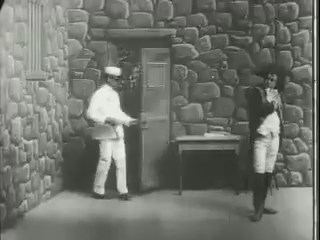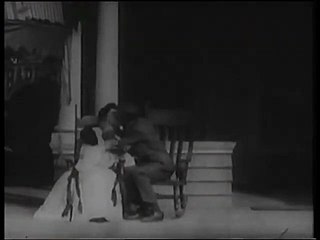
The Motion Picture Patents Company, founded in December 1908 and effectively terminated in 1915 after it lost a federal antitrust suit, was a trust of all the major US film companies and local foreign-branches, the leading film distributor and the biggest supplier of raw film stock, Eastman Kodak. The MPPC ended the domination of foreign films on US screens, standardized the manner in which films were distributed and exhibited within the US, and improved the quality of US motion pictures by internal competition. It also discouraged its members' entry into feature film production, and the use of outside financing, both to its members' eventual detriment.
The year 1903 in film involved many significant events in cinema.

The Biograph Company, also known as the American Mutoscope and Biograph Company, was a motion picture company founded in 1895 and active until 1916. It was the first company in the United States devoted entirely to film production and exhibition, and for two decades was one of the most prolific, releasing over 3000 short films and 12 feature films. During the height of silent film as a medium, Biograph was the most prominent U.S. film studio and one of the most respected and influential studios worldwide, only rivaled by Germany's UFA, Sweden's Svensk Filmindustri and France's Pathé. The company was home to pioneering director D. W. Griffith and such actors as Mary Pickford, Lillian Gish, and Lionel Barrymore.

The Lubin Manufacturing Company was an American motion picture production company that produced silent films from 1896 to 1916. Lubin films were distributed with a Liberty Bell trademark.

Le Voyage de Gulliver à Lilliput et chez les Géants, released in the United States as Gulliver's Travels Among the Lilliputians and the Giants and in the United Kingdom as Gulliver's Travels—In the land of the Lilliputians and the Giants, is a 1902 French silent trick film directed by Georges Méliès, based on Jonathan Swift's 1726 novel Gulliver's Travels.

Maniac Chase is a 1904 American short silent comedy film directed by Edwin S. Porter and produced by the Edison Manufacturing Company. The film is a remake of The Escaped Lunatic, a film directed by Wallace McCutcheon Sr. released at the beginning of 1904. This was one of two Biograph Company hits remade by Edison's company in fall 1904, the other being Personal, which was copied as How a French Nobleman Got a Wife Through the New York Herald Personal Columns.

Terrible Teddy, the Grizzly King is a 1901 American silent film directed by Edwin S. Porter. Produced by the Edison Manufacturing Company, it is the earliest known political satire in American film. It features three actors, all of whom are unknown.
Wallace McCutcheon Sr. was a pioneer cinematographer and director in the early American motion picture industry, working with the American Mutoscope & Biograph, Edison and American Star Film companies. McCutcheon's wealth of credits are often mixed up with the small handful of films directed by his son, Wallace McCutcheon Jr. (1884–1928).

Love by the Light of the Moon is a 1901 film by Edwin S. Porter, produced by the Edison Manufacturing Company. It mixes animation and live action and predates the man in the Moon theme of the 1902 French science fiction film A Trip to the Moon by Georges Méliès. The animation is provided by projected slides showing the Moon's different faces.
How Brown Saw the Baseball Game is an American short silent comedy film produced in 1907 and distributed by the Lubin Manufacturing Company. The film follows a baseball fan named Mr. Brown who overdrinks before a baseball game and becomes so intoxicated that the game appears to him in reverse motion. During production, trick photography was used to achieve this effect.
The Bold Bank Robbery is a 1904 short crime film produced and distributed by the Lubin Manufacturing Company. The silent film depicts a group of burglars who plan and execute a successful bank heist. Company employee Jack Frawley was the film's director, also coming up with the story and serving as cinematographer; the cast's identities are unknown. The silent film was the first Lubin Manufacturing Company release to feature an original narrative.

Kansas Saloon Smashers is a 1901 comedy short film produced and distributed by Edison Studios. Directed by Edwin S. Porter, it is a satire of American activist Carrie Nation. The film portrays Nation and her followers entering and destroying a saloon. After the bartender retaliates by spraying Nation with water, policemen order them out; the identities of the actors are not known. Inspiration for the film was provided by an editorial cartoon which appeared in the New York Evening Journal.

Meet Me at the Fountain is a 1904 American silent short comedy film written, produced, and directed by Siegmund Lubin. Actors in the movie included Gilbert Sarony, a well-known cross-dressing performer. The film was inspired by Wallace McCutcheon's 1904 film Personal.

The Child Stealers also known as The Kidnapped Child or Child Stealing is a 1904 British silent crime film about kidnapping, directed by William Barker and produced by the Warwick Trading Company.

The Widow and the Only Man is a 1904 American short silent comedy film produced by the American Mutoscope & Biograph Company and directed by Wallace McCutcheon, Sr.

On the morning of June 13, 1914, a disastrous fire and a series of related explosions occurred in the main film vault of the Lubin Manufacturing Company in Philadelphia, Pennsylvania. Several possible causes for the blaze were cited at the time, one being "spontaneous combustion" of highly flammable nitrate film, which was the motion picture industry's standard medium for cameras throughout the silent era and for the first two decades of "talking pictures". Millions of feet of film were consumed in the flames, including most of the master negatives and initial prints of Lubin's pre-1914 catalog, several of the company's recently completed theatrical prints ready for release and distribution, a considerable number of films produced by other studios, inventories of raw and stock footage, hundreds of reels documenting historic events that occurred between 1897 and early 1914, as well as other films related to notable political and military figures, innovations in medical science, and professional athletic contests from that period. While this fire was not a decisive factor in Lubin's decline and bankruptcy by September 1916, costs associated with the disaster only added to the corporation's mounting debts, which led to the closure or sale of its remaining operations the following year.

The Whole Dam Family and the Dam Dog is a 1905 silent short comedy film directed by Edwin S. Porter for the Edison Manufacturing Company. The five-and-a-half minute film was an adaptation of a popular picture postcard featuring a humorously named family. The film introduces each member of the Dam family, and then shows a raucous dinner scene that ends with the Dam dog pulling the tablecloth off the table, and ruining the Dam meal.

Dog Factory is a 1904 silent comic trick film directed by Edwin S. Porter for the Edison Manufacturing Company. The four-and-a-half minute film offers a comic twist on a popular idea from film and vaudeville. The film concerns two inventors who run a "Dog Factory", in which strings of sausages can be fed into a machine, and turned into live dogs. The film has been described as an early example of science-fiction.

The Old Maid Having Her Picture Taken is a 1901 silent short film directed by Edwin S. Porter in collaboration with George S. Fleming. The comic film depicts an unattractive old woman arriving at a photo studio to have her picture taken, and destroying all of the equipment through the power of her ugliness.

The Gay Shoe Clerk is a 1903 silent short film directed by Edwin S. Porter. The film depicts a risqué comic encounter between a clerk and his female customer while she is trying on shoes.

















